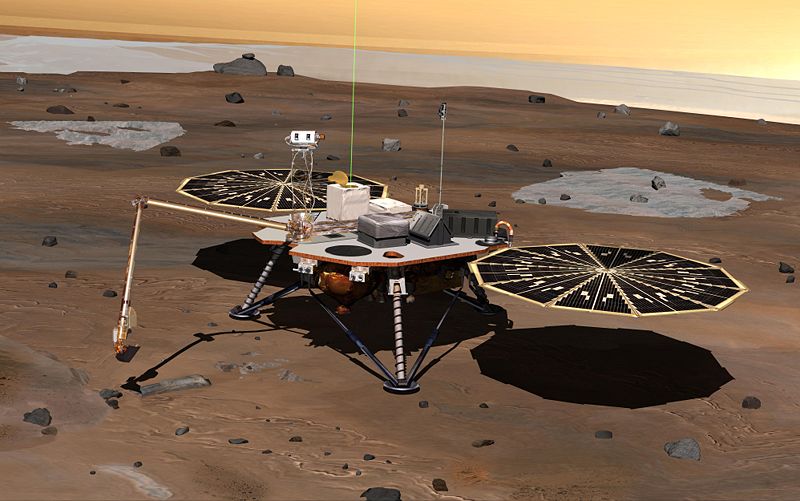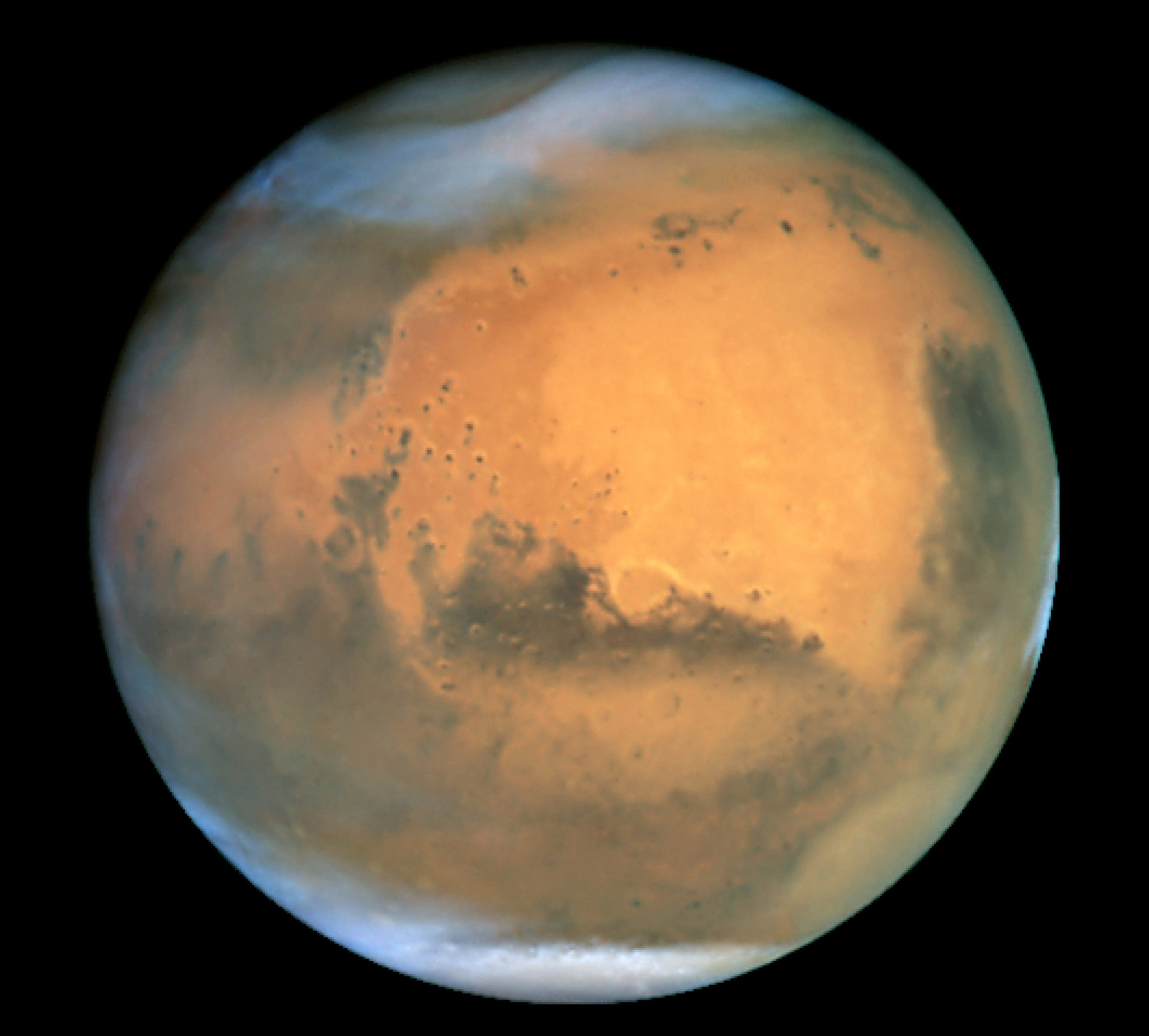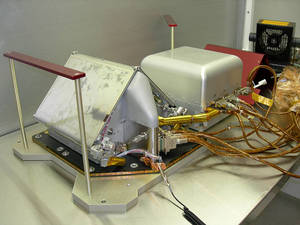The Phoenix Mission
Interview with
Chris - The Phoenix is literally hours away from touching down. You must be pretty nervous?
William - I am. It's been a long wait and there's not too much we can do about it now but we're just going to watch and hope everything works well.
Chris - Just tell us a bit about Phoenix. What is it first of all?
 William - Phoenix is a lander. It's unlike the rovers that are currently scooting about Mars. This does not have wheels. We're going to land in one location near the North Pole of Mars. Wherever we land that's where we stay. It does have a robotic arm that can reach out a little bit less than 2m in any direction and dig up some dirt and deliver it to my instruments: a thermal evolved gas analyser and another instrument that has a microscope and wet chemistry lab and be analysing the soils that it digs up.
William - Phoenix is a lander. It's unlike the rovers that are currently scooting about Mars. This does not have wheels. We're going to land in one location near the North Pole of Mars. Wherever we land that's where we stay. It does have a robotic arm that can reach out a little bit less than 2m in any direction and dig up some dirt and deliver it to my instruments: a thermal evolved gas analyser and another instrument that has a microscope and wet chemistry lab and be analysing the soils that it digs up.
Chris - What key questions are you looking to answer?
William - I guess the big key question is to understand the environment and see if it could have been either now, or more likely in the past, hospitable for life. The mission is not really a life detection mission such as Viking was a long while ago. This mission is more to understand the conditions and just see if Mars might have been hospitable for life.
Chris - Why have you picked the North Pole?
William - We're there in large part because we've found there's ice just beneath the surface. This was a discovery made with another instrument I've been involved with: a gamma ray spectrometer on the Mars Odyssey Mission. We found that the whole North Polar region, northward of about 60 degrees latitude, has very large amounts of ice just buried a centimetre or two beneath the surface. What we're thinking is that ice might provide a special environment to preserve conditions. Perhaps organic molecules might have survived.
Chris - What sort of ice is that? Is that water ice?
 William - Yes. This, what we're speaking of is water ice. As I think one of your earlier guests mentioned when we land we might see a bit of CO2 frost on the surface. During the winter time on Mars it gets cold enough that the atmosphere, which is almost pure CO2, will condense out on the surface and we can have in the order of 1m thick layer of CO2 frost covering the ground. The ice I'm talking about here is regular water ice that would be beneath the surface. There's a lot of it: as best we can tell somewhere in the order of 70-85% ice and maybe only 20% dirt.
William - Yes. This, what we're speaking of is water ice. As I think one of your earlier guests mentioned when we land we might see a bit of CO2 frost on the surface. During the winter time on Mars it gets cold enough that the atmosphere, which is almost pure CO2, will condense out on the surface and we can have in the order of 1m thick layer of CO2 frost covering the ground. The ice I'm talking about here is regular water ice that would be beneath the surface. There's a lot of it: as best we can tell somewhere in the order of 70-85% ice and maybe only 20% dirt.
Chris - What season is it at the moment on Mars?
William - Right now it's springtime. The ground is warming up. The CO2 frost is leaving, It's possible when we get there all the CO2 frost will be gone. We might still see some in the shadow regions behind rocks. It is warming up.
Chris - When you say warming up, you mean relatively speaking? That's still pretty cold, isn't it?
William - It's still pretty cold. We expect the temperatures will be about -40 or something like that. Perhaps the middle of the day getting warmer.
Chris - How long will the mission last? How long will Phoenix be able to tolerate those conditions to do the experiments?
William - We expect the hardware itself to survive about six months. So far the mission is only scheduled to go for three months and if everything is going well we're hopeful that NASA will come up with some extra money that we can go for another three months. The craft is solar powered and since we're near the North Pole once the winter starts we lose the sunshine so there's no longer any power for the lander itself.
Chris - What's actually going to happen today and what are the steps as Phoenix comes in to land on Mars?
William - It's actually pretty involved process but what happens is it enters the top of the atmosphere. It has a heat shield very much like the one the Apollo capsule or the same idea as what the space shuttle had when it re-entered. It can withstand high temperatures and is essentially something that can get very hot and use friction to slow the space craft down, a large fraction of the speed. Then what happens is they get rid of that heat shield and they deploy a parachute which slows it down still more. Because Mars' atmosphere is very thin as one of your earlier guests pointed out the parachute doesn't do too well in terms of slowing us down but it will still slow us down. The final bit we do with retrorockets. It's kind of an old fashioned way of doing it compared to what was done more recently with air bags surrounds.
 Chris - That was Beagle 2 and it didn't go so well. We don't know what happened to Beagle 2.
Chris - That was Beagle 2 and it didn't go so well. We don't know what happened to Beagle 2.
William - That's true, we don't. It was also the same technology used on the moon rovers though which did survive and Pathfinder as well. The problem is when the landers get to be very big the airbags get to be very big and it get'smore difficult to we're going back to the technology that we used on the Viking mission and we're very hopeful that this will set us down very gently.
Chris - Thank you very much for joining us, William. I hope that you'll be able to join us in a few months' time when it's all gone well, fingers crossed. And you'll have some data for us.
William - I'd be very happy to do that.










Comments
Add a comment